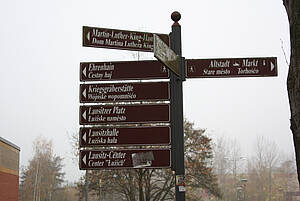Hoyerswerda as a crucible? Local processes of remembering in a post-socialist industrial city since 1989
 |
In the context of the rapid industrialisation of the GDR from the 1950s onwards, the small town of Hoyerswerda grew to become the ‘second socialist city’ after Eisenhüttenstadt. The construction of the ‘Black Pump’ coal refinery combine in the district of Cottbus (foundation stone laid in 1955), the largest investment in GDR industry in the late 1950s and 1960s, promised jobs and housing. Nearby Hoyerswerda became home to the workforce of the ‘Black Pump’, eventually accommodating around 70,000 people in high-rise flats. Many of these new residents were expellees, mainly from Silesia and Czechoslovakia. The migration city of Hoyerswerda became the planned city of a political ideology. It was a ‘new space’ for ‘new people’. At the end of the Cold War the transformation of politics, industry and society in the new Germany got underway. In this context Hoyerswerda became a shrinking city. By 2011 its population had plummeted to just 36,000.
Against the background of the pluralist and democratic urban society that emerged after 1989 and in the context of historical (master) narratives from state socialist times, the project examines processes of remembering in the interaction of local agents (local branches of political parties, migrant and non-migrant organisations, (citizens’) initiatives and municipal institutions). In addition to acts of collective remembering reported on by the media (commemorative events, public speeches, written documents, exhibitions), the project focuses on negotiations of memory in the internal discussions of certain organisations.
To what extent are the ‘big’ national debates on (forced) migration and war events reflected in the local context? Can we identify even partially ‘autonomous’ forms of remembering in Hoyerswerda? What role is played by the memories of the xenophobic excesses of September 1991, which made Hoyerswerda a byword for extreme right-wing violence in the east of the Federal Republic? And how do the experiences of oppression and suffering in the communist era shape memory processes in this city? The collective memories of the ‘domovina’ (the association of the Lusatian Sorbs), which was founded in 1912 in Hoyerswerda, will also be considered in the project.
K. Erik Franzen has set up a blog on this project on the hypotheses.org platform: http://hoyerswerda.hypotheses.org/

Mitglied im

